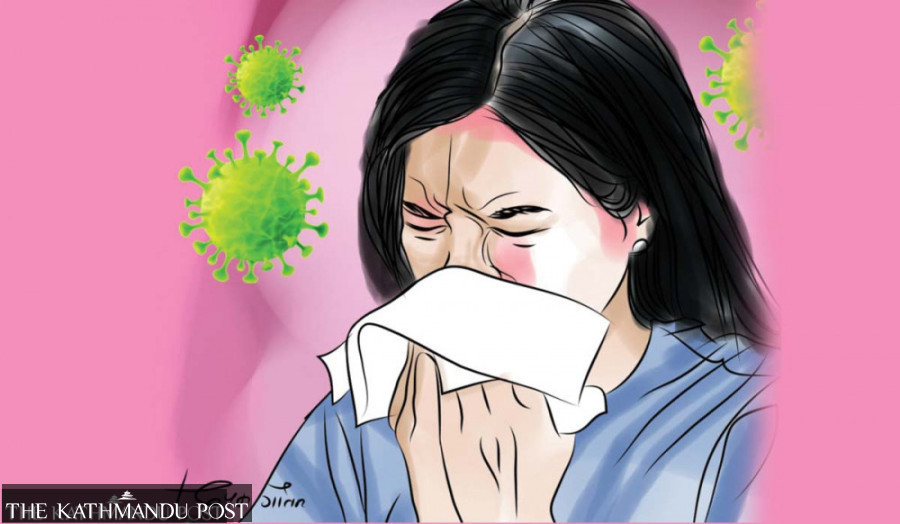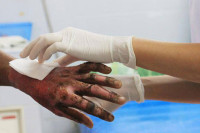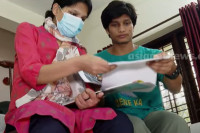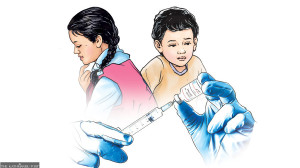Health
Nepal doctors warn of rising respiratory co-infections from multiple viruses
Back-to-back or simultaneous infections can cause pneumonia and severe deterioration in health, say experts.
Arjun Poudel
A few days ago, a woman in her mid-50s suffering from a respiratory illness was rushed to the emergency ward of a private hospital. Her relatives informed the doctor that she had recovered from a flu just a week earlier. Test results showed that the patient had been infected with another virus back to back.
“The number of patients with respiratory diseases has risen of late,” said Dr Raju Pangeni, a pulmonary and critical care physician at Hams Hospital. “The rise is seen not only in the out-patient’s department but also in the emergency ward and among in-patients. Some of these patients have been admitted to the intensive care unit.”
What concerns respiratory disease experts and virologists is that multiple respiratory viruses have been circulating in communities and some patients have been infected by different viruses back to back, and others are suffering from co-infection, or simultaneous infections by two viruses.
According to data from the National Public Health Laboratory (NPHL), as many as 1,313 people tested positive for influenza viruses in 2024. Of them 952 were infected with influenza A(H1N1) also known as swine flu virus, 253 with influenza B, and 108 with A(H3), also known as the Hong Kong flu.
The overall positivity rate for influenza virus was 16.1 percent, which is too high, according to experts.
“Since the start of January, the test positivity rate has jumped to 18 percent,” said Dr Ranjan Raj Bhatta, director at the laboratory. “As winter is flu season, cases of respiratory illnesses generally rise.”
Additionally, 431 people tested positive for SARS-CoV-2, the coronavirus, with a test positivity rate of 5.5 percent, according to data from the NPHL. Lab officials reported 13 cases of co-infection—12 patients had A(H1N1) and coronavirus; and one was infected with influenza B virus and coronavirus.
“Infections with respiratory viruses back to back or simultaneously could lead to pneumonia and severe health deterioration,” said Pangeni.
Doctors say cases of respiratory illness have risen in communities as well, but most patients are not seeking care. Only serious patients including those suffering from pneumonia are seeking hospital care, according to them.
“There might be flu or cold patients at almost every home,” said Dr Sher Bahadur Pun, chief of Clinical Research Unit at Sukraraj Tropical and Infectious Disease Hospital. “Small children and people with compromised immunity can get severe from respiratory viruses.”
Doctors say seasonal influenza viruses can cause respiratory complications and harm the lungs. These viruses spread quickly in communities and can cause fever, cough, body aches, occasional vomiting, diarrhoea, and pneumonia.
Experts say early diagnosis is crucial to prevent complications. Patients recover early if treated on time, but delay in treatment can increase both the severity of the disease and deaths.
“Many people take the infection lightly and do not seek treatment,” said Pun. “Negligence can prove costly if the patients are small children and elderly.”
Doctors said some patients, especially children with flu and fever are found to have developed pneumonia as well.
Pneumonia, an infection of the lungs caused by various types of bacteria, viruses and fungi, is the number one killer of children under five in Nepal. It kills more children annually than malaria, tuberculosis and HIV combined.
Fifteen percent of the total under-five mortality is caused by pneumonia, according to the World Health Organisation.
Doctors say pneumonia caused by bacteria is deadlier than that caused by viruses, and children under five and people above 65 years of age are highly vulnerable to the disease.
Public health measures—mask-wearing, handwashing, avoiding crowds, and maintaining social distancing—can reduce infection, according to doctors.
“More people would have been infected had schools not announced winter vacations,” said Pangeni. “The same public health measures, which we learned during the coronavirus pandemic, are equally effective in preventing other respiratory illnesses.”
Doctors also recommend immunisation with flu shots, especially for the elderly and people with compromised immunity.




 17.12°C Kathmandu
17.12°C Kathmandu













%20(1).jpg&w=300&height=200)
